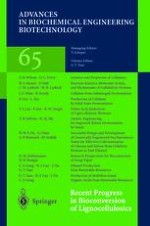1999 | OriginalPaper | Buchkapitel
Dilute-Acid Hydrolysis of Lignocellulosic Biomass
verfasst von : Y. Y. Lee, Prashant Iyer, R. W. Torget
Erschienen in: Recent Progress in Bioconversion of Lignocellulosics
Verlag: Springer Berlin Heidelberg
Enthalten in: Professional Book Archive
Aktivieren Sie unsere intelligente Suche, um passende Fachinhalte oder Patente zu finden.
Wählen Sie Textabschnitte aus um mit Künstlicher Intelligenz passenden Patente zu finden. powered by
Markieren Sie Textabschnitte, um KI-gestützt weitere passende Inhalte zu finden. powered by
In recent years, treatment of lignocellulosic biomass with dilute sulfuric acid has been primarily used as a means of hemicellulose hydrolysis and pretreatment for enzymatic hydrolysis of cellulose. A significant advancement has also been made in the area of dilute acid hydrolysis of cellulose. An overview of reactor theory as it applies to the dilute acid hydrolysis and recent developments in the process technology are discussed. The focus of the new development is the emergence of a counter-current shrinking-bed reactor. In a counter-current reactor scheme, the major portion of the sugar is produced near the liquid outlet point. This minimizes the residence time for the sugar to decompose. Bed shrinking occurs due to partial solubilization of the solid biomass. A properly designed shrinking-bed reactor can reduce the liquid throughput thus raising the sugar concentration. A broader range of reaction conditions has also been explored. These activities contribute to a phenomenal improvement in the dilute acid hydrolysis technology placing it to the point where it can compete with the enzymatic process.
